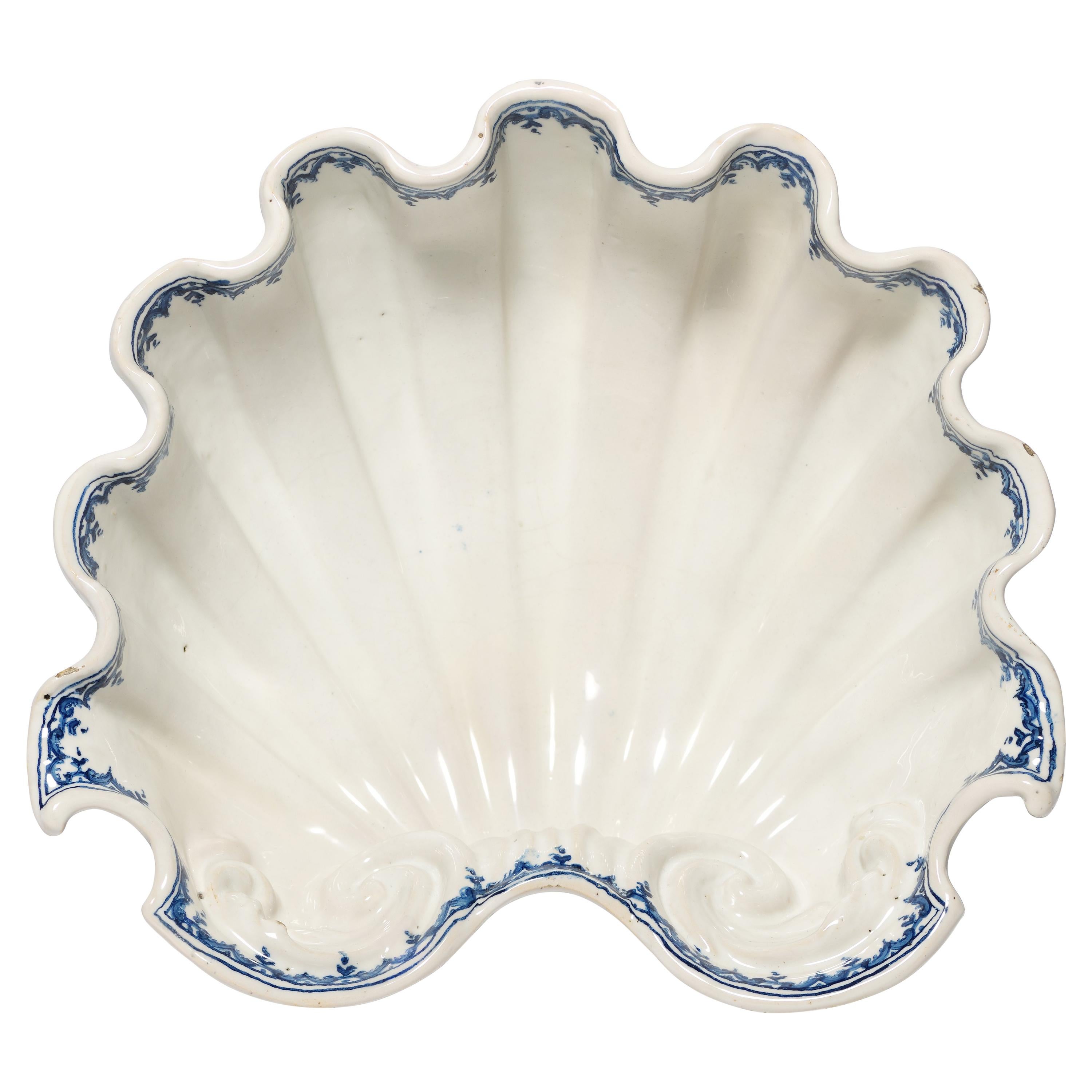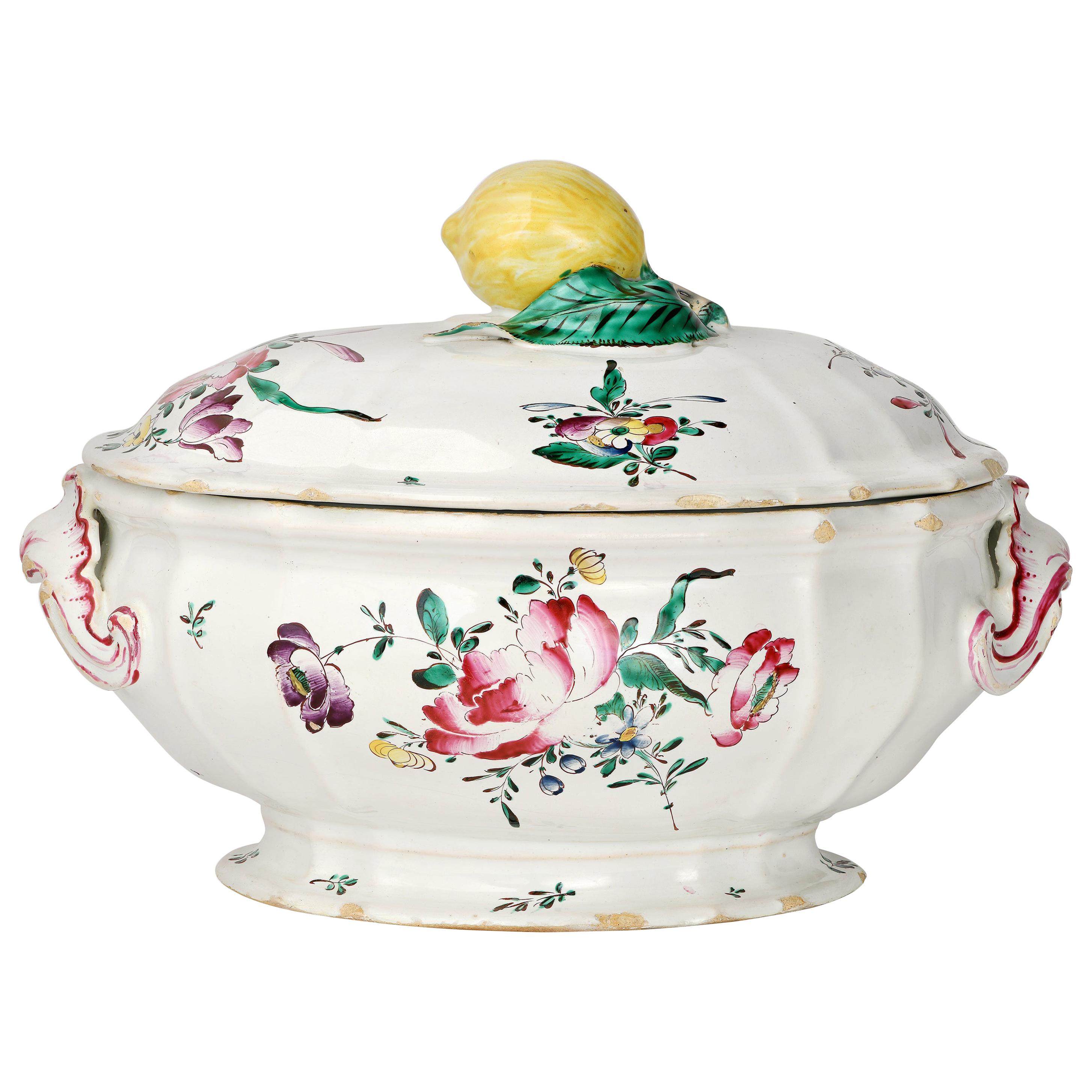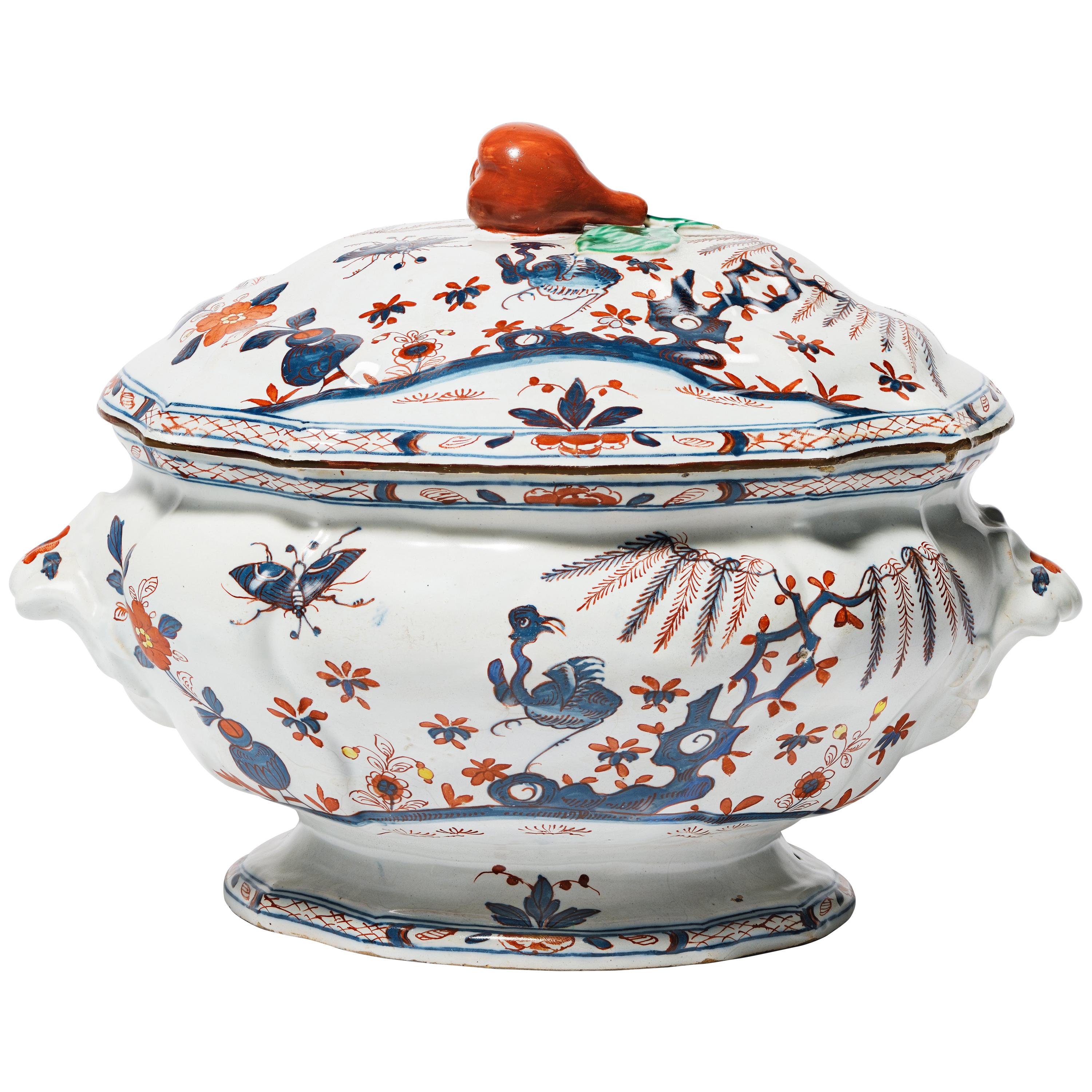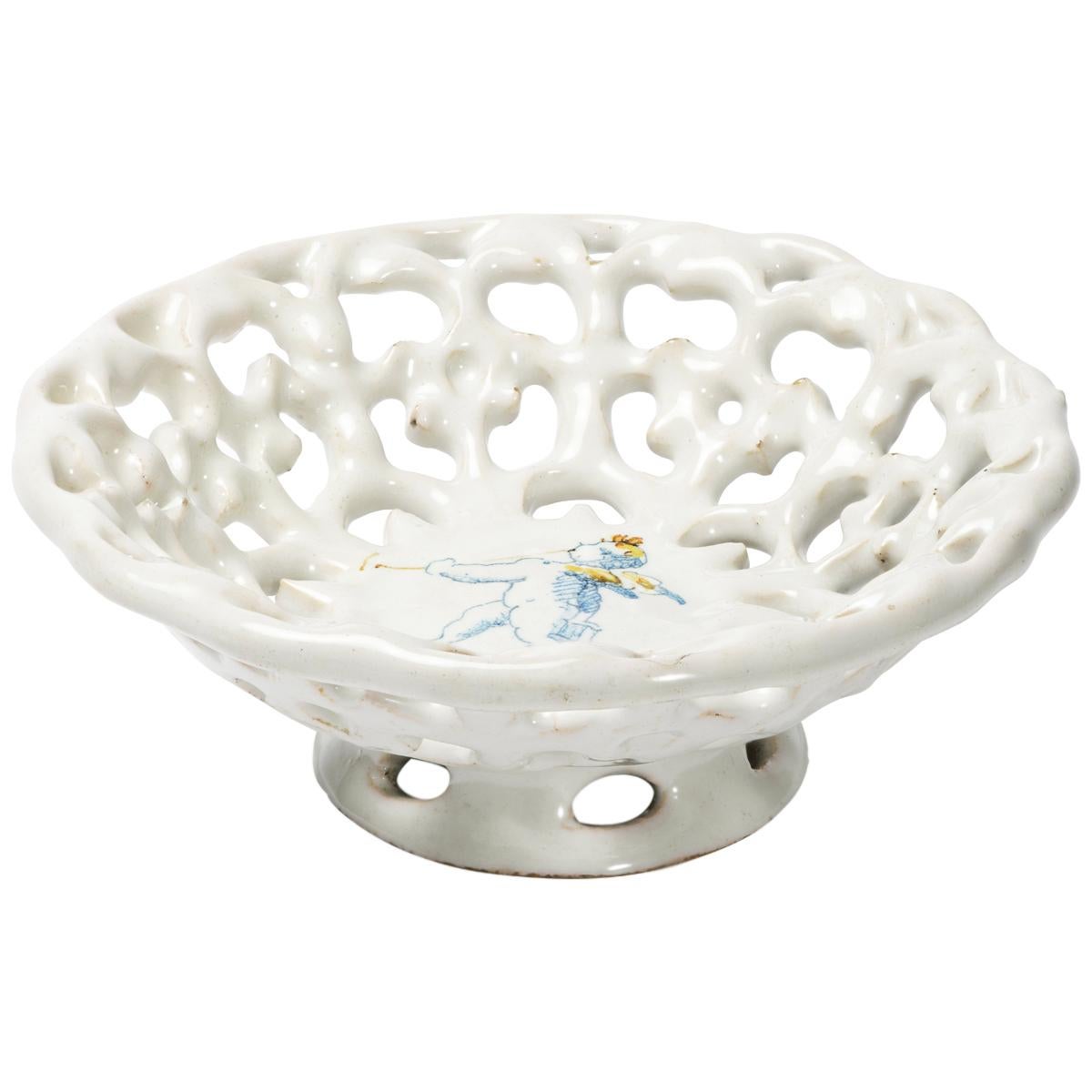Items Similar to Ancient Maiolica Tiles, Rampini Manufactory, Pavia, 1693-1704
Video Loading
Want more images or videos?
Request additional images or videos from the seller
Ancient Maiolica Tiles, Rampini Manufactory, Pavia, 1693-1704
About the Item
Six maiolica “ambrogette” (tiles)
Rampini manufactory, painter probably Siro Antonio Africa
Pavia, 1693-1704
a) 6.88 x 5.51 in (17.5 x 14 cm); 0.55 lb (252 g)
b) 7.08 x 5.70 in (18 x 14.5 cm); 0.51 lb (233 g)
c) 6.88 x 5.70 in (17.5 x 14.5 cm); 0.54 lb (245 g)
d) 6.81 x 5.51 in (17.3 x 14 cm); 0.50 lb (230 g)
e) 6.88 x 5.51 in (17.5 x 14 cm); 0.50 lb (229 g)
f) 7.08 x 5.70 in (18 x 14.5 cm); 0.51 lb (233 g)
State of conservation: intact.
These six ”maiolica fina” small “ambrogette” belong to a family of ceramic works considered among the finest produced between the 17th and 18th centuries. For a long time, this type of maiolica was attributed to the Venetian village of Angarano, but later it was definitively attributed to the pottery factories in Pavia. A fundamental study ascribed this production specifically to Pavia through an analysis of Lombard collections and a comparison with archaeological remains found near the two main manufacturing sites in the city. (E. Pelizzoni - M. Forni - S. Nepoti, La maiolica di Pavia tra Seicento e Settecento, Milano 1997).
The six small oval tiles have rounded edges and are decorated with a historiated motif. They were created using high-fired polychrome technique, with a predominance of cool tones and a dominance of gray and blue, interspersed with manganese, citrine yellow, orange-yellow, and green. The six small “ambrogette” are characterized by the same stylistic features, with a similar decorative design.
The first tile (a) depicts a female figure, holding a stiletto and sitting near a pedestal supporting a relief-decorated baluster vase. Behind her, a child is holding a chalice, while through the arches of a portico, a glimpse of a mountainous landscape can be seen in the background. The female figure could possibly be Lucretia, an example of virtue in ancient Roman culture.
In the second “ambrogetta” b), the Biblical episode of Judith and Holofernes is depicted through canonical iconography: the decapitated body of Holofernes lies on the bed in the background, while the protagonist, Judith, is seen placing his head into a sack held by a maidservant. Through an archway a shining slice of the moon gives the perception of nighttime. Surprisingly, within the narrative, there is the presence of a basin in the shape of a large shell, closely resembling the products of Pavia's factories.
The third small plaque (c) depicts a female figure standing on a plinth and framed by an architectural arch with a vast mountainous landscape in the background. The woman, with her breasts exposed, is accompanied by two children: one approaching her as if wanting to be picked up, and the other seated with an apple in his hand. The protagonist lends herself to different interpretations: perhaps she represents Rea Silvia with the two twin founders of Rome, or perhaps she is an allegory for the Pietà, a common theme depicted on maiolica.
In the fourth tile (d), three characters are depicted near a column. The main figure is an old man with a sad expression, holding a cup, while a woman, wearing a turban on her head, also holds a cup in her right hand and a pitcher in her left. A second woman with her hair bound holds another pitcher behind the old man: at his feet a traveller's bag can be seen, along with some apples and a slice of cheese on a rectangular base. It is likely the sad Biblical episode of Lot and his daughters, at the moment when they get him drunk in an effort to restore the human race after the destruction of Sodom.
The last two “ambrogette”, (e) and (f), give more prominence to the landscape, populated by small figures of travellers resting. They are characterized by consistent architectural elements, such as the depiction of an Allegory of Music in the tile (e), or the representation of a horse statue on a pedestal in tile (f). In the latter, a family of wayfarers sits on the left, leaving ample room for a landscape that opens up in perspective, enriched by mountains and distant turreted architecture.
The six tiles were likely part of a decorative series incorporated into wooden supports, possibly a piece of furniture or a frame, or another type of ornamental structure, as described in documents regarding the use of works by "Africa" in Lombard interiors: "six oval maiolica pieces by Africa, also enclosed by carved and gilded wooden frames." (Asp, Notarile di Pavia, G. Re, 13013, 16 agosto 1743).
The use of maiolica tiles as architectural decoration is also demonstrated by the "tiles inserted between stucco volutes to adorn a room in the Palazzo Ghislieri Aizaghi Malaspina, later chiselled out and sold after the death of the last owner, Abbot Spallanzani." (P. Pavesi, L’abate Spallanzani a Pavia, in Memorie della società italiana di scienze naturali e Museo Civico di Storia naturale di Milano, VI-III. Milan 1901, pp. 18-19). The information documents how this significant ceramic production was perceived as early as the 18th century - Lazzaro Spallanzani died in Pavia in 1799 - as being outside of contemporary taste, and subsequently fell into oblivion for more than two centuries.
The pictorial style corresponds to that of the Africa family: it is likely that these works were directly influenced by Siro Antonio Africa, the most refined maiolica painter of the late 17th-century Lombard decorative culture.
The decorator Siro Antonio Africa, along with his nephew Siro Domenico, had worked alternately in the two main Pavia factories (Carlo Giuseppe Rampini and Antonio Francesco Imbres as documented from the last decades of the seventeenth century) where he signed his works in a different way (E. Pelizzoni in, op. cit., pp. 29-32). In the 1735 inventories of the Rampini manufactory, the maiolica were defined with the architecture of Africa. He is considered among the initiators of refined decoration with architecture, of which this work is one of the finest examples. Preserved in the major ceramics museums of the world, the dishes of Pavia are considered among the most elegant works among the eighteenth-century maiolica.
Our oval plaques find particularly close comparisons with the maiolica pieces preserved in some private collections and within the Collection of Applied Arts at the Castello Sforzesco in Milan. (R. Ausenda, a cura di, Musei e Gallerie di Milano. Museo d’Arti Applicate. Le ceramiche, Tomo II, Milan 2001, pp. 101-104, nn. 111-114). A very close comparison in terms of quality and pictorial style can also be made with a centerpiece from the Francesco Franchi collection in the Pinacoteca of Varallo Sesia, depicting a banquet scene with satyrs and bacchantes. (G. Anversa, La collezione Francesco Franchi e la donazione alla Pinacoteca di Varallo Sesia, Borgosesia 2004, p. 302, n. 157).
The pictorial technique of the tiles, where the figures stand out on architectural pedestals juxtaposed with rigorous structures that frame perspective backgrounds and meticulously described landscapes, finds a prestigious comparison in pieces of notable scenic impact, such as the large vase from the D'Azeglio collection at the Civic Museum of Palazzo Madama in Turin. (Pellizzoni, op. cit., p. 173).
This pictorial and stylistic uniformity is also recognizable in the inspiration taken from contemporary engravings: the figures are painted in diluted manganese brown with rounded faces, characterized by small mouths, almost standardized with serious and somewhat melancholic expressions, reminiscent of some engravings based on the drawings of Johann Christoff Storer, who was active in Lombardy during that period. For example, one can observe how the figure of "Purity" by Storer (cod. catalogo nazionale n. 0300619948-7) has been used in tile (c), where the painter reproduces the pose from the engraving, but modifies it in terms of clothing, hairstyle, and, above all, the nature of the character itself, which here represents "Charity."
This approach is found in many characters derived from the well-known engraving by Sole Giovan Dal Gioseffo and Giovanni Paolo Bianchi, with Storer still being the creator. In this engraving, part of the illustrative apparatus for the funeral of Isabella of Spain is depicted, featuring an overall view of the interior of the Cathedral, with allegorical statues representing the virtues of the deceased Queen.
The same approach of freely interpreting engravings can also be seen in the figure of the wayfarer, leisurely reclining in the shade of the columns, in the tile with the Allegory of Music (e). The character here resembles the beggar placed in the foreground in Jacopo Cotta's engraving depicting a triumphal entry (numero catalogo generale: 00636266, Civica Raccolta di Incisioni Serrone Villa Reale), which is also based on a drawing by Storer.
The "ambrogettes" were placed, probably in the 19th century, in 18th-century style carved and gilded wooden frames.
Bibliography:
P. Pavesi, l’abate Spallanzani a Pavia, in Memorie della società italiana di scienze naturali e Museo Civico di Soria naturale di Milano, VI-III. Milano 1901, pp. 18-19;
E. Pelizzoni - M. Forni - S. Nepoti, La maiolica di Pavia tra Seicento e Settecento, Milano 1997;
R. Ausenda, a cura di, Musei e Gallerie di Milano. Museo d’Arti Applicate. Le ceramiche, Tomo II, Milano 2001, pp. 101-104, nn. 111-114.
- Attributed to:Siro Antonio Africa (Painter)
- Dimensions:Height: 7.09 in (18 cm)Width: 5.71 in (14.5 cm)Depth: 0.2 in (5 mm)
- Sold As:Set of 6
- Style:Baroque (Of the Period)
- Materials and Techniques:
- Place of Origin:
- Period:1700-1709
- Date of Manufacture:circa 1700
- Condition:Intact.
- Seller Location:Milano, IT
- Reference Number:1stDibs: LU4352236559352
About the Seller
4.3
Vetted Seller
These experienced sellers undergo a comprehensive evaluation by our team of in-house experts.
Established in 1860
1stDibs seller since 2018
19 sales on 1stDibs
Typical response time: 1 hour
Associations
International Confederation of Art and Antique Dealers' Associations
- ShippingRetrieving quote...Ships From: Milano, Italy
- Return PolicyA return for this item may be initiated within 14 days of delivery.
More From This SellerView All
- Ancient Italian Maiolica Faenza, Ferniani Factory, Circa 1700By Ferniani FactoryLocated in Milano, ITCenterpiece light blue maiolica shell Ferniani factory, early period: 1693-1776 Faenza, 1700 circa 5.5 in x 14.72 in x 13.77 in (14 cm x 37.4 cm X cm 35) lb 4.40 (kg 2) State of con...Category
Antique Early 1700s Italian Baroque Ceramics
MaterialsMaiolica
- Ancient Italian Maiolica Faenza, Ferniani Factory, Circa 1700By Ferniani FactoryLocated in Milano, ITCenterpiece white maiolica shell Ferniani factory, early period: 1693-1776 Faenza, circa 1700 Measures: 5.6 in x 14.72 in x 13.46 in (14.3 cm x 37.4...Category
Antique Early 1700s Italian Baroque Ceramics
MaterialsMaiolica
- Maiolica Oval Tray, Felice Clerici Manufactory, Milan, Circa 1770-1780By Felice ClericiLocated in Milano, ITSmall oval tray Felice Clerici Manufactory 1745-1780 Milan, Circa 1770-1780 Maiolica polychrome. Dimensions: 10.82 x 8.66 in (27.5 x 22 cm); weight 0.4...Category
Antique 1770s Italian Rococo Ceramics
MaterialsMaiolica
- Italian Maiolica Ancient Tureen, Lodi, 1770-1780By Antonio FerrettiLocated in Milano, ITMaiolica tureen Antonio Ferretti Manufacture Lodi, circa 1770-1780 Maiolica polychrome decorated “a piccolo fuoco” (third fire). It measures 9.05 x 12.59 x 9.05 in (23 x 32 x 23 cm) ...Category
Antique 1770s Italian Rococo Ceramics
MaterialsMaiolica
- Ancient Italian Maiolica Tureen Milano, 1770 circaBy Felice Clerici, Pasquale RubatiLocated in Milano, ITMaiolica tureen “allo struzzo” (ostrich decoration) Milan, Felice Clerici or Pasquale Rubati factory, circa 1750-1780 Measures: 9.25 in x 12.79 in x 10.23 in (cm 23.5 x cm 32.5 x cm 26) lb 4.78 (kg 2.17) State of conservation, a felûre consolidated inside with slight edge chipping restored. In Milan in the 18th century two Majolica warehouses were opened, the first, by Felice Clerici, in 1745, the second in 1756 by Pasquale Rubati. Traditionally this type of decoration has been attributed to the Pasquale Rubati factory. In reality the motif “allo struzzo”, one of the clearest examples of how the taste for chinoiserie met with considerable success during the 18th century, had been produced, in specimens of greater or lesser quality, by both Milanese manufactories. This Maiolica tureen has a swollen and ribbed oval bowl, rests on an extroflexed foot and shows stirrup handles. The tri-color ornament, in the typical tones of Japanese "Imari" decorations, shows an idealized oriental landscape that develops around a perforated rock and has a willow tree with long lance-shaped leaves framing the long-legged bird figure. The ornamentation is enhanced by decorative elements such as butterflies, small florets and a vase with a thin flowery stem. The lid is ribbed with a pear-shaped knob on top. The decoration was called in the Milanese manufactories "allo struzzo" (ostrich decoration) and this refers to the oriental figure Xian He or the crane, symbol of longevity, here losing its symbolic value. It is hypothesized that among some 16th century engravings...Category
Antique 1770s Italian Chinoiserie Ceramics
MaterialsMaiolica
- Italian Maiolica Ancient Sugar Bowl, Lodi, 1770-1780By Antonio FerrettiLocated in Milano, ITMaiolica sugar bowl Antonio Ferretti Manufacture Lodi, Circa 1770-1780 Maiolica polychrome decorated “a piccolo fuoco” (third fire). It measures 3.54 x 4.52 x 3.54 in (9 x 11,5 x 9 cm) Weight: 0.394 lb (0.179 kg) State of conservation: small and slight chips on the edges. The small sugar bowl has a swollen and ribbed body resting on a flat base. The cap-shaped lid follows the rib of the container and is topped with a small knob in the shape of a two-colored fruit. The sugar bowl is painted “a piccolo fuoco” (third fire) with the characteristic floral motif of bunches and isolated semis. An example which closely corresponds to this one is kept at the Civic Museum in Lodi (G. Gregorietti, Maioliche di Lodi, Milano e Pavia, Catalogo della Mostra, Milano, 1964 n. 137). This decorative style represented a strong point of the Lodi factory, which established itself thanks to the vivid nature of the colors made possible by the introduction of a new technique perfected by Paul Hannong in Strasbourg and later introduced by Antonio Ferretti to Italy. The production process, called “piccolo fuoco” (third fire), allowed the use of a greater number of colors than in the past; in particular, the purple of Cassius, a red made from gold chloride, was introduced. Its use allowed for many more tones and shades, from pink to purple. The Ferretti family started their maiolica manufacturing business in Lodi in 1725. The forefather Simpliciano started the business by purchasing an ancient furnace in 1725 and, indeed, we have evidence of the full activity of the furnaces starting from April of the same year (Novasconi-Ferrari-Corvi, 1964, p. 26 n. 4). Simpliciano started a production of excellence also thanks to the ownership of clay quarries in Stradella, not far from Pavia. The production was so successful that in 1726 a decree of the Turin Chamber came to prohibit the importation of foreign ceramics, especially from Lodi, to protect internal production (G. Lise, La ceramica a Lodi, Lodi 1981, p. 59). In its initial stages, the manufacture produced maolicas painted with the “a gran fuoco” (double fire) technique, often in turquoise monochrome, with ornamentation derived from compositional modules in vogue in Rouen in France. This was also thanks to the collaboration of painters like Giorgio Giacinto Rossetti, who placed his name on the best specimens next to the initials of the factory. In 1748 Simpliciano made his will (Gelmini, 1995, p. 30) appointing his son Giuseppe Antonio (known as Antonio) as universal heir. After 1750, when Simpliciano passed away, Antonio was directly involved in the maiolica factory, increasing its fortunes and achieving a reputation on a European level. Particularly important was the aforementioned introduction in 1760 of the innovative “a piccolo fuoco” (third fire) processing, which, expanding the ornamental repertoire with Saxon-inspired floral themes, was able to commercially compete with the German porcelains that had one of its most renowned offerings in the naturalistic Deutsche Blumen. Antonio Ferretti understood and promoted this technique and this decoration, proposing it in a fresher and more corrective version, less linked to botanical tables, both with or without contour lines, as well as in purple or green monochrome. After efforts to introduce more industrial production techniques to the sector succeeded, even the Ferretti manufacture, in the last decade of the eighteenth century, started heading towards decline despite its attempts to adapt production to neoclassical tastes. In 1796 the Napoleonic battle for the conquest of the Lodi bridge over the Adda definitively compromised the furnaces. Production resumed, albeit in a rather stunted manner, until Antonio's death on 29 December 1810. (M. L. Gelmini, pp. 28-30, 38, 43 sgg., 130-136 (for Simpliciano); pp. 31 sgg., 45-47, 142-192 (for Antonio). Bibliography G. Gregorietti, Maioliche di Lodi Milano e Pavia Catalogo della Mostra, Milano, 1964 n. 137; C. Baroni, Storia delle ceramiche nel Lodigiano, in Archivio storico per la città e i comuni del circondario e della diocesi di Lodi, XXXIV (1915), pp. 118, 124, 142; XXXV (1916), pp. 5-8; C. Baroni, La maiolica antica di Lodi, in Archivio storico lombardo, LVIII (1931), pp. 453-455; L. Ciboldi, La maiolica lodigiana, in Archivio storico lodigiano, LXXX (1953), pp. 25 sgg.; S. Levy, Maioliche settecentesche lombarde e venete, Milano 1962, pp. 17 sgg.; A. Novasconi - S. Ferrari - S. Corvi, La ceramica lodigiana, Lodi 1964, ad Indicem; Maioliche di Lodi, Milano e Pavia (catal.), Milano 1964, p. 17; O. Ferrari - G. Scavizzi, Maioliche italiane del Seicento e del Settecento, Milano 1965, pp. 26 sgg.; G. C. Sciolla, Lodi. Museo civico, Bologna 1977, pp. 69-85 passim; G. Lise, La ceramica a Lodi, Lodi 1981; M. Vitali, in Storia dell'arte ceramica...Category
Antique 1770s Italian Rococo Ceramics
MaterialsMaiolica
You May Also Like
- Teruel (Aragon) - Spanish Maiolica Mortar, 17th centuryLocated in DELFT, NLCeramic mortar produced at the Teruel pottery workshops in the 17th century. It has a truncated cone shape with three handles and a pourer. It is tin-...Category
Antique 17th Century Spanish Baroque Ceramics
MaterialsMaiolica
- Italian Maiolica Crespina a Compendiario Style, Center Italy, Late 17th CenturyLocated in CHItalian Maiolica Crespina a Compendiario style, Central Italy, Late 17th century This Crispina has a convex shape on the front and a concave shape on the back, resting on a small ...Category
Antique Late 17th Century Italian Baroque Ceramics
MaterialsMaiolica
- 16 ANCIENT MAJOLICA TILES FROM THE LIBERTY ERA 1894 / 1910 Art NouveauBy Europa AntiquesLocated in Madrid, ES16 ANCIENT MAJOLICA TILES FROM THE LIBERTY ERA 1894 / 1910 Art Nouveau Original white and manganese relief tile. Relief tile. AVAILABILITY OF 329 TILES HEIGHT 80 cm WIDTH 80 cm TH...Category
Early 20th Century Italian Art Nouveau Ceramics
MaterialsCeramic
- 16 ANCIENT MAJOLICA TILES FROM THE LIBERTY ERA 1894 / 1910 Art NouveauBy Europa AntiquesLocated in Madrid, ES16 ANCIENT MAJOLICA TILES FROM THE LIBERTY ERA 1894 / 1910 Art Nouveau Original white and manganese relief tile. Relief tile. AVAILABILITY OF 106 TILES HEIGHT 80 cm WIDTH 80 cm TH...Category
Early 20th Century Italian Art Nouveau Ceramics
MaterialsCeramic
- 16 ANCIENT MAJOLICA TILES FROM THE LIBERTY ERA 1894 / 1910 Art NouveauBy Europa AntiquesLocated in Madrid, ES16 ANCIENT MAJOLICA TILES FROM THE LIBERTY ERA 1894 / 1910 Art Nouveau Original white and manganese relief tile. Relief tile. AVAILABILITY OF 142 TILES HEIGHT 80 cm WIDTH 80 cm TH...Category
Early 20th Century Italian Art Nouveau Ceramics
MaterialsCeramic
- 16 ANCIENT MAJOLICA TILES FROM THE LIBERTY ERA 1894 / 1910 Art NouveauBy Europa AntiquesLocated in Madrid, ES16 ANCIENT MAJOLICA TILES FROM THE LIBERTY ERA 1894 / 1910 Art Nouveau Original white and manganese relief tile. Relief tile. AVAILABILITY OF 310 TILES HEIGHT 80 cm WIDTH 80 cm TH...Category
Early 20th Century Italian Art Nouveau Ceramics
MaterialsCeramic
Recently Viewed
View AllMore Ways To Browse
Ceramic Art Wave Germany
Colin Cowie
Chinoiserie Footbath
Campaign Gueridon
Cheese Keeper
Etruscan Majolica
Glass Cheese Keeper
Johnson Brothers Vintage Patterns
Josef Hoffman Silver
Lane Octagon
Turquoise Glass Urn
Elly Kuch
Jens Quistgaard Pottery
Majolica Salt And Pepper
Portuguese Crab Plate
Chinese Export Tankard Mug
Conti Glass
Fan Dancer Lorenzl





